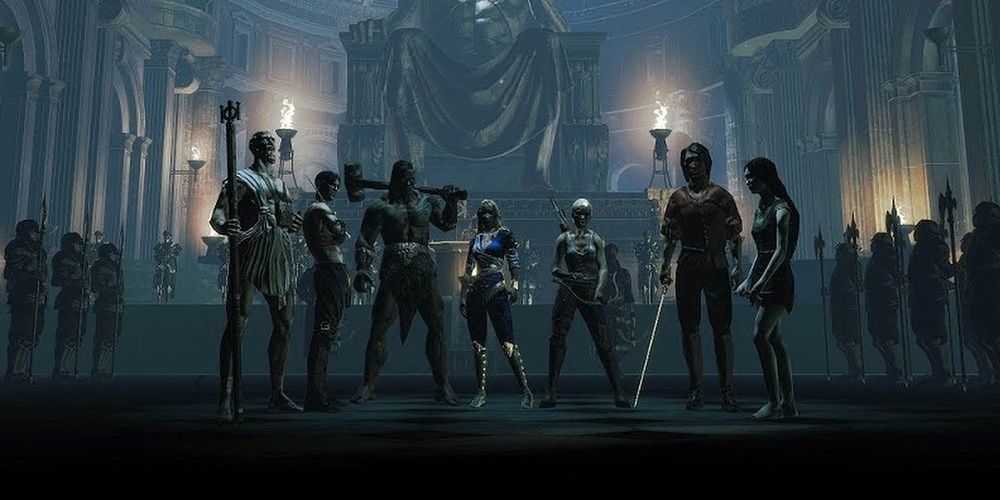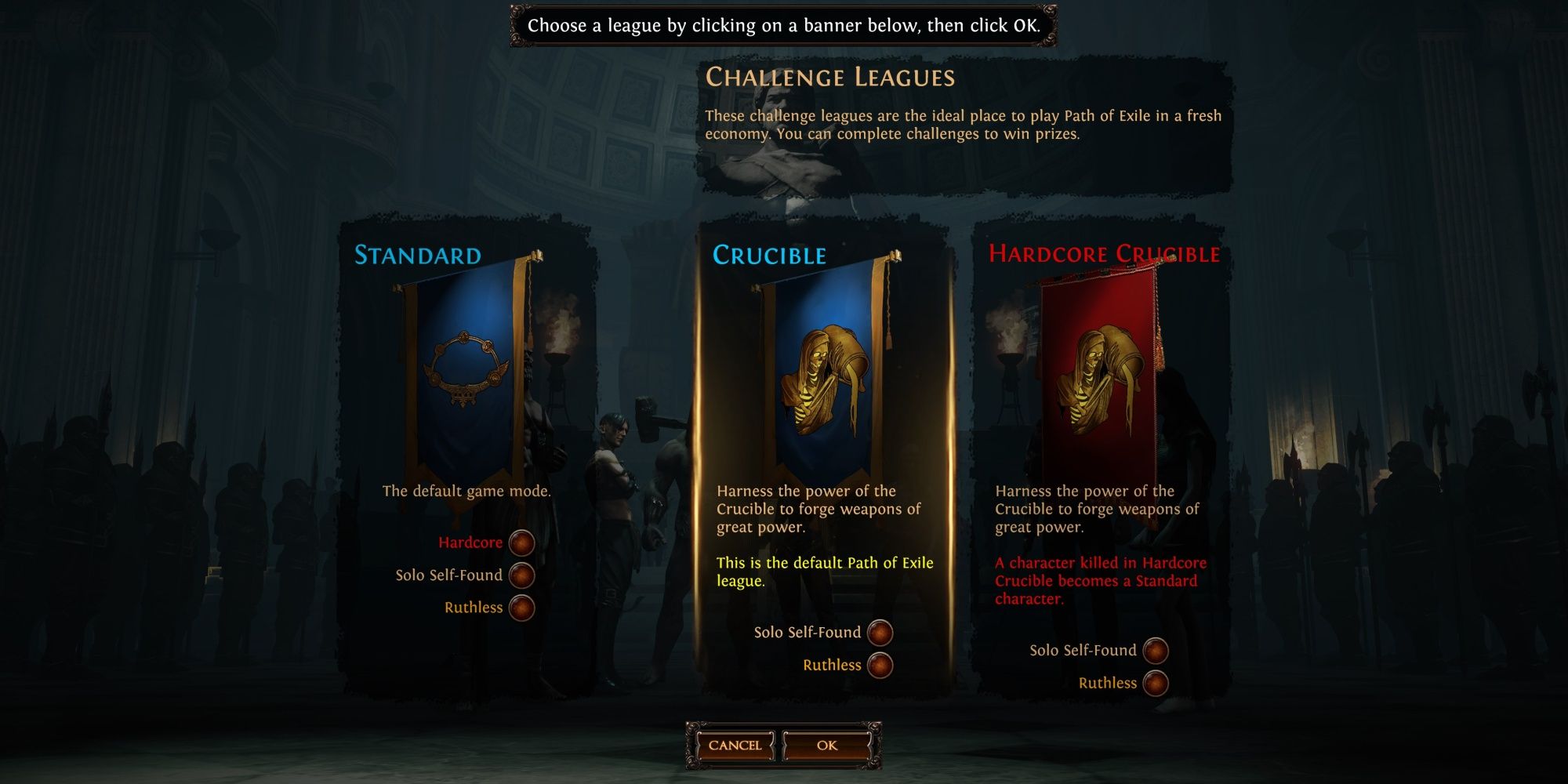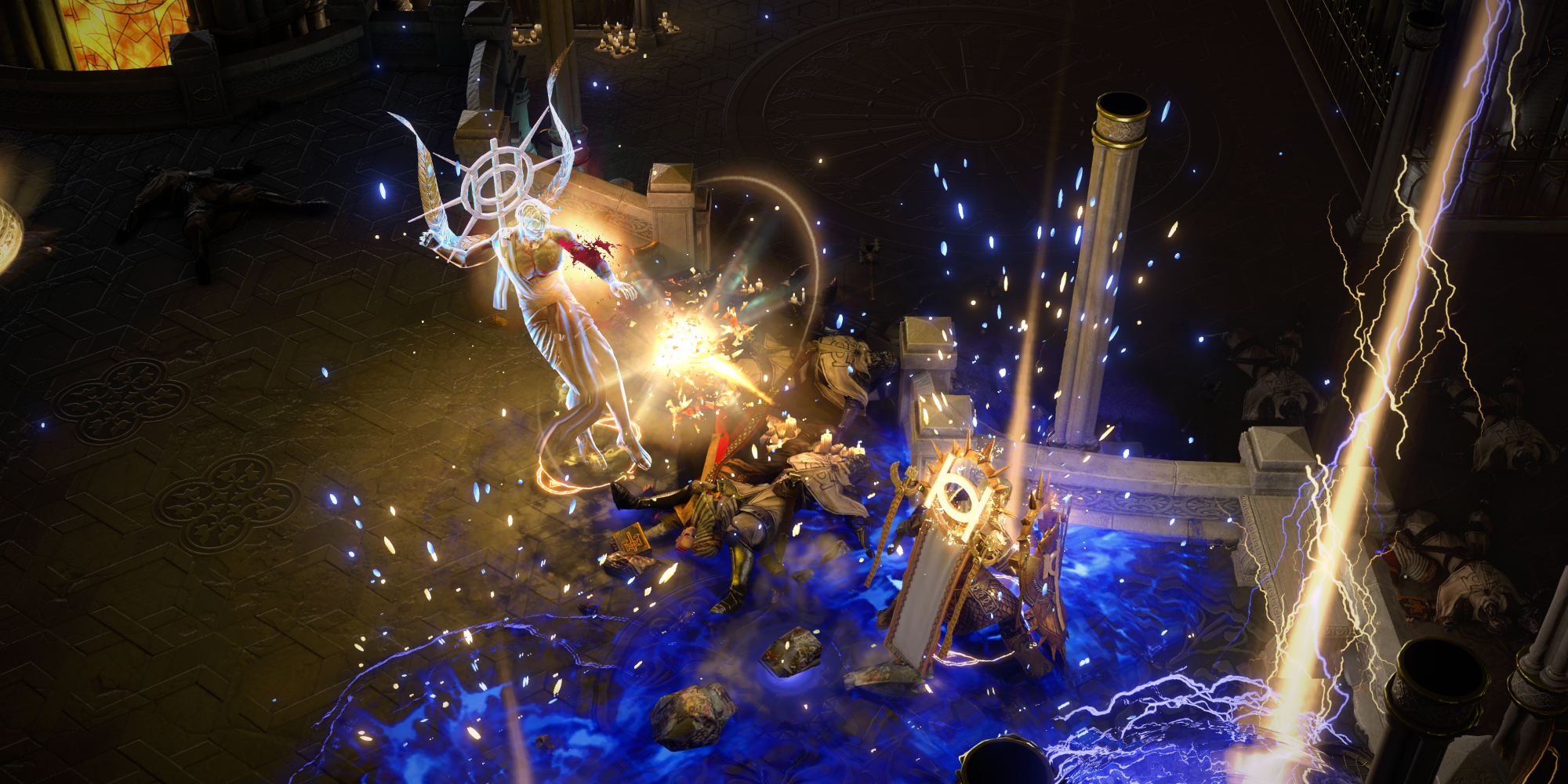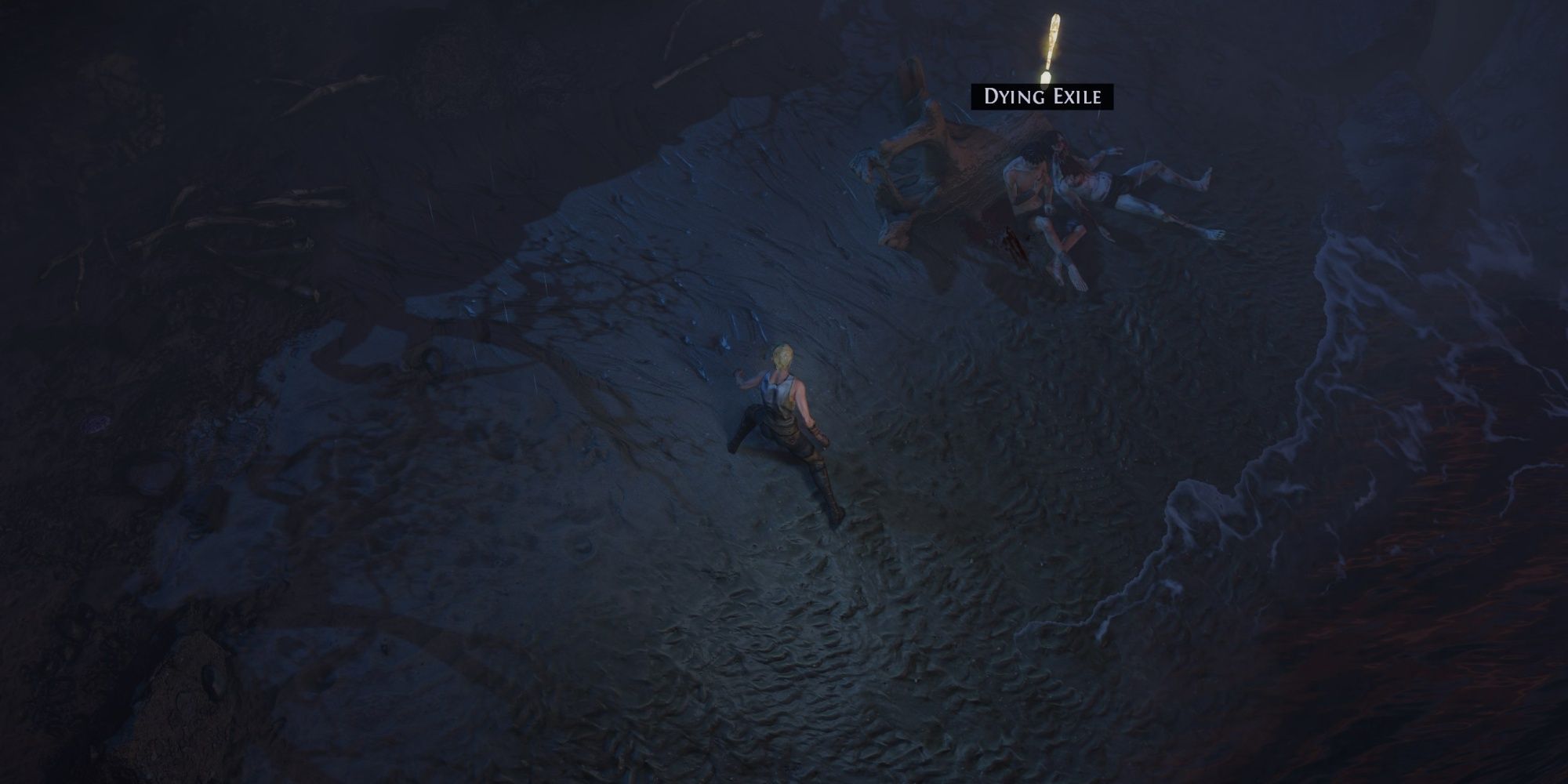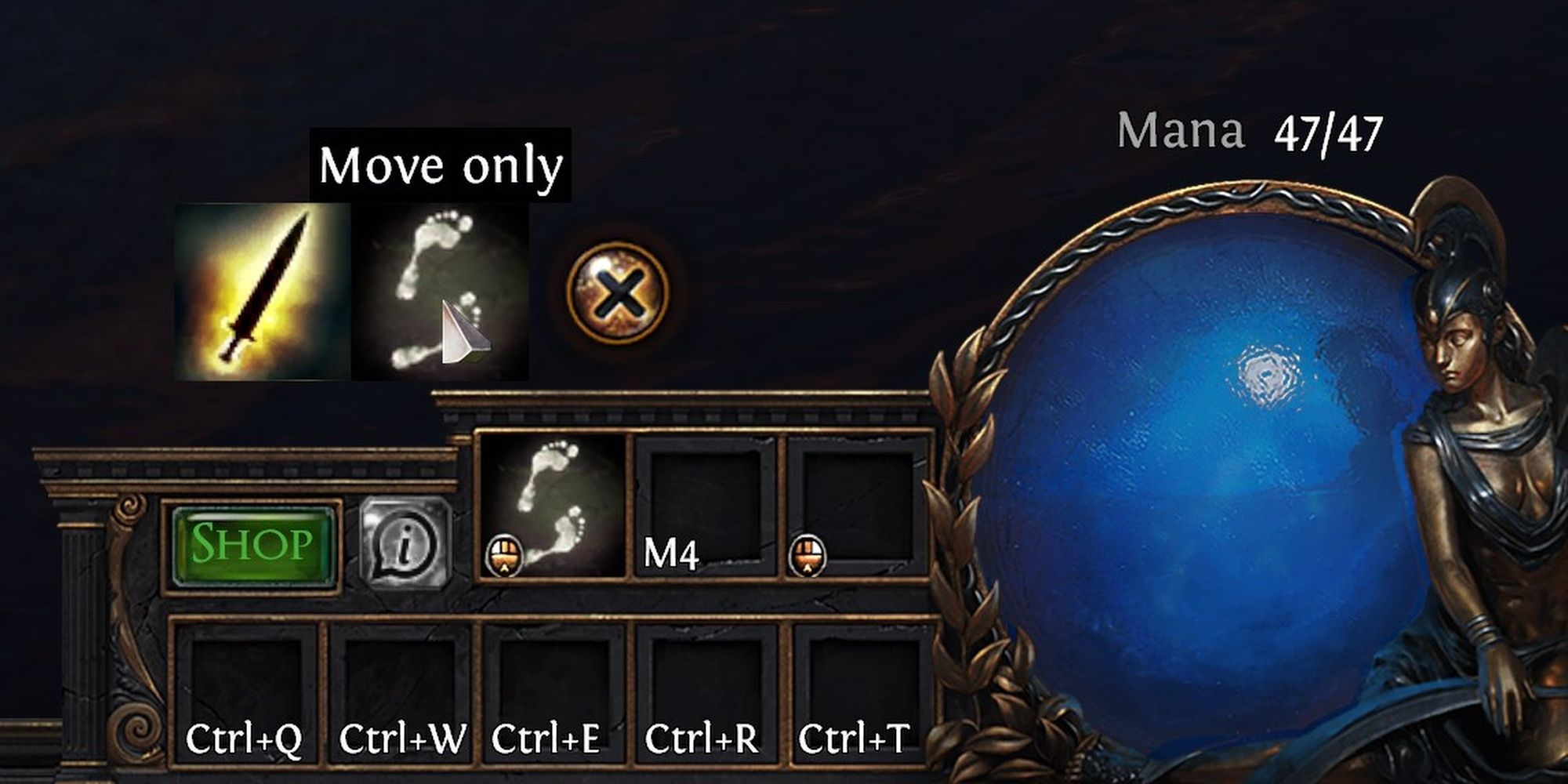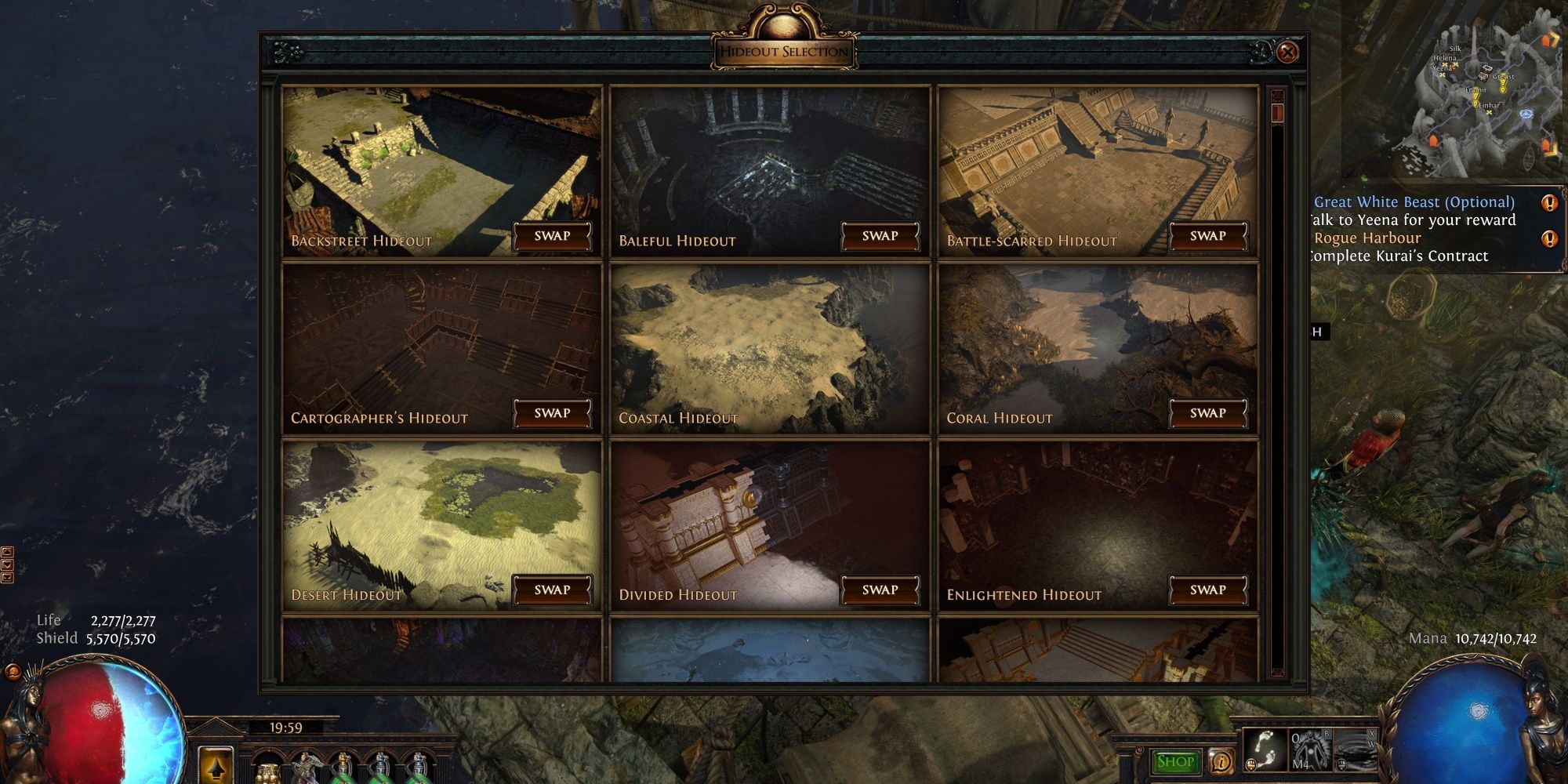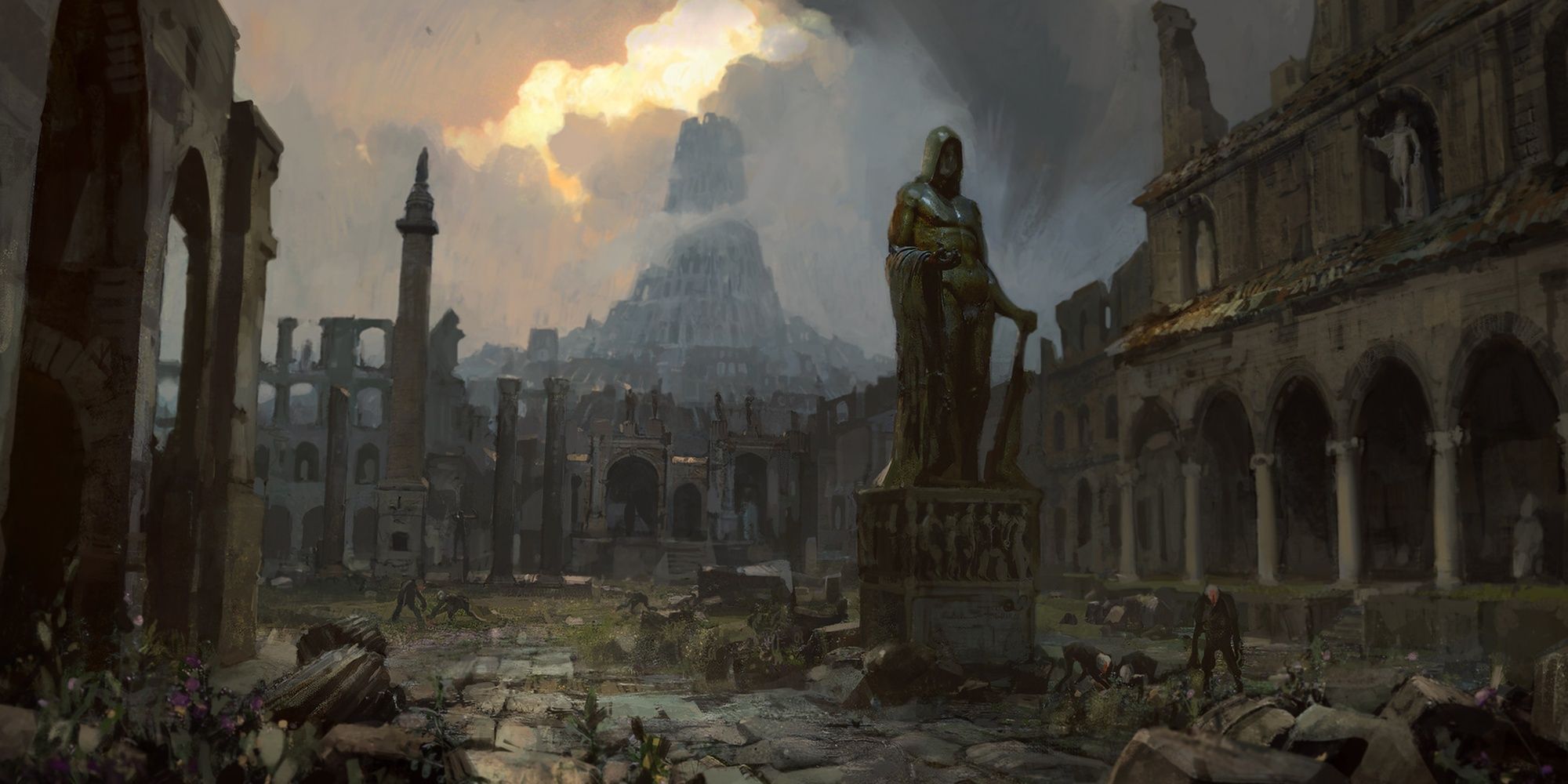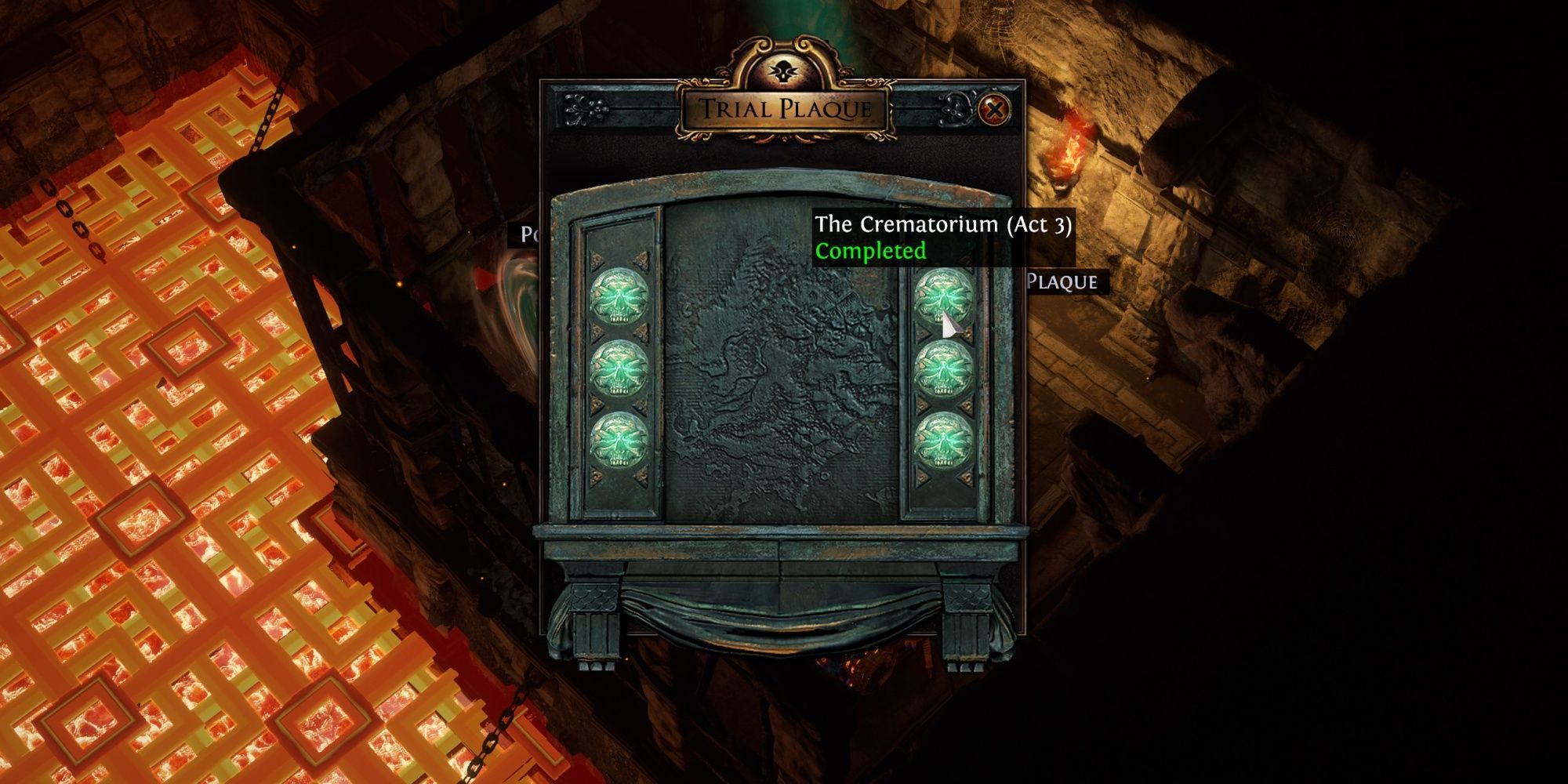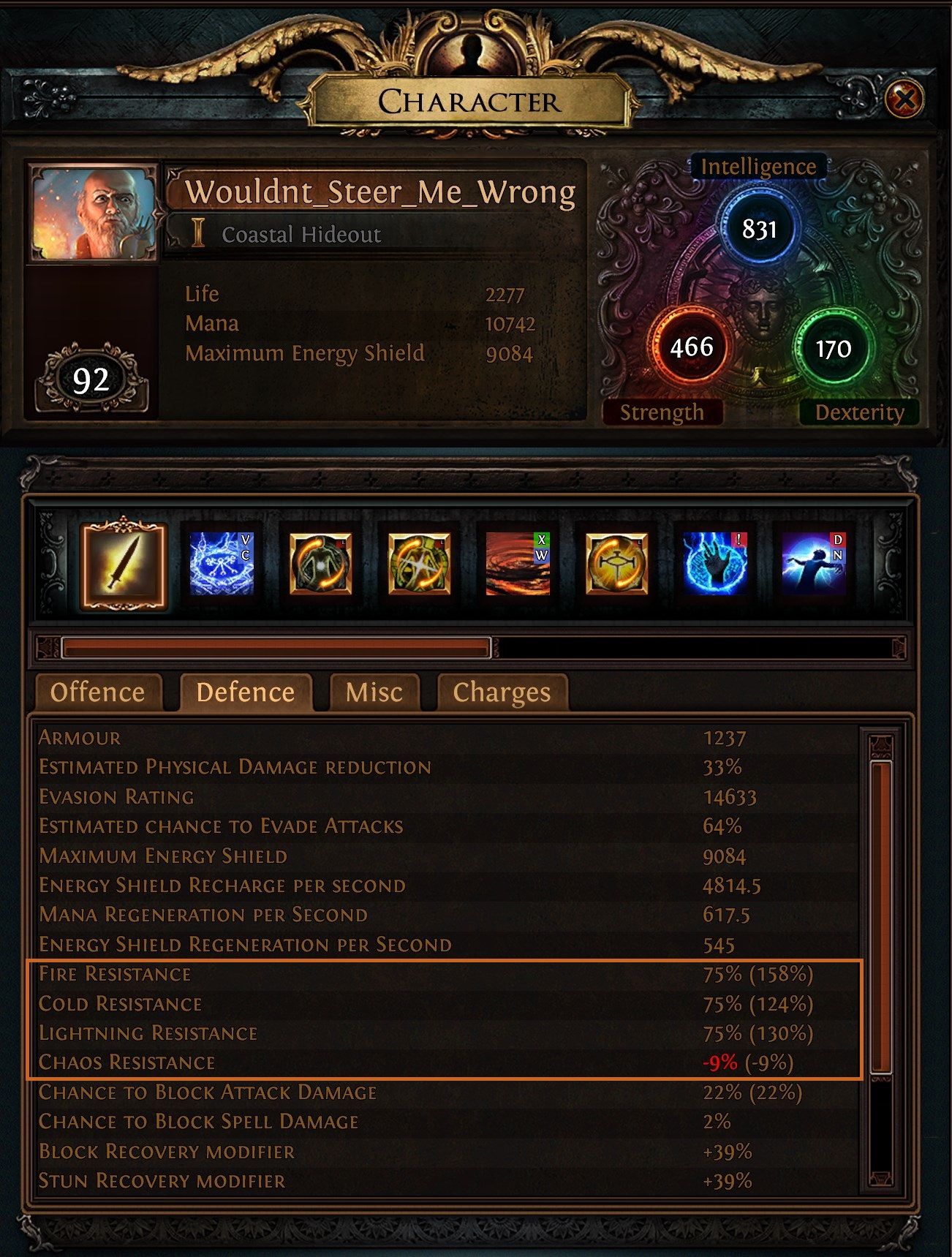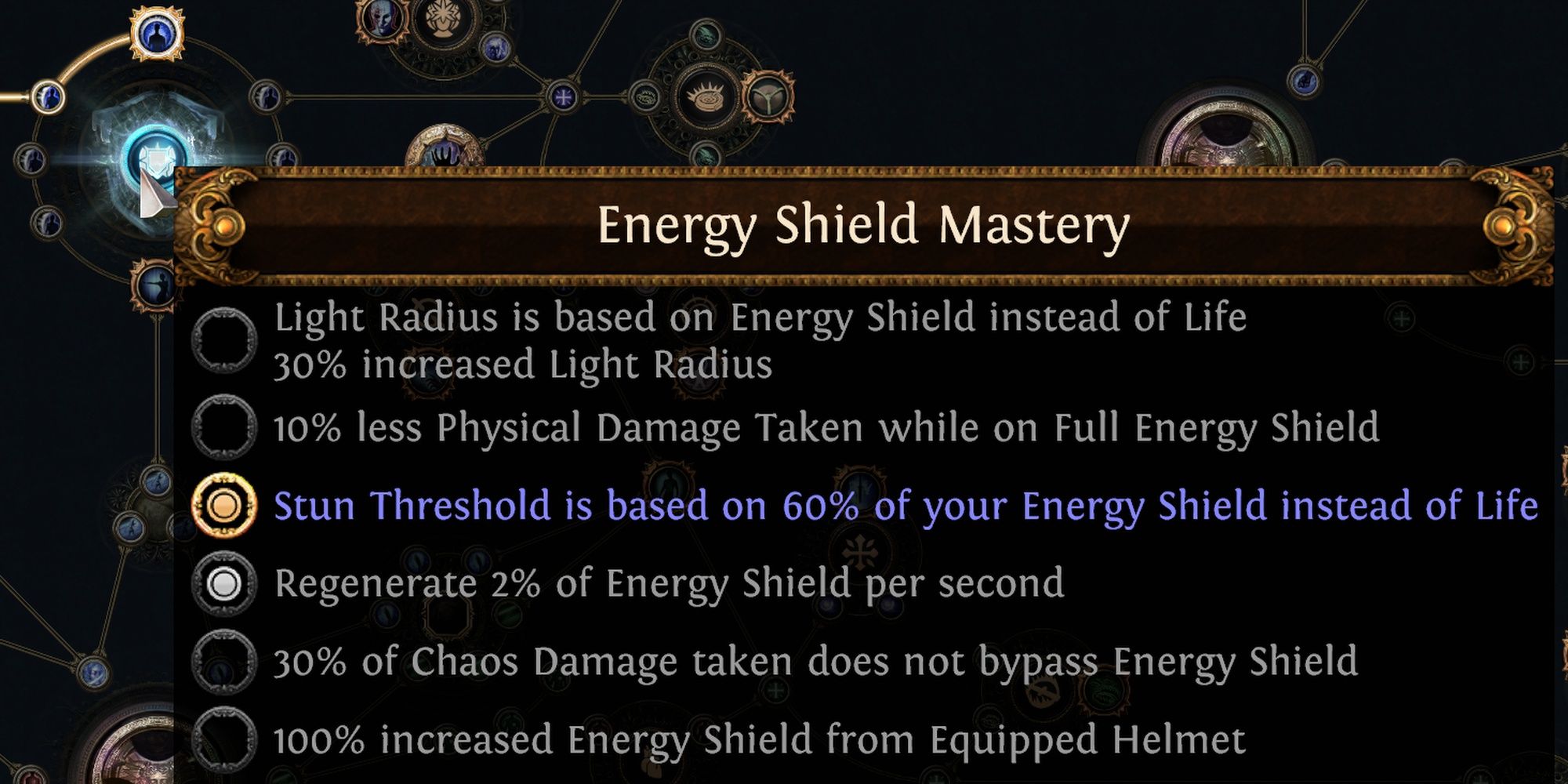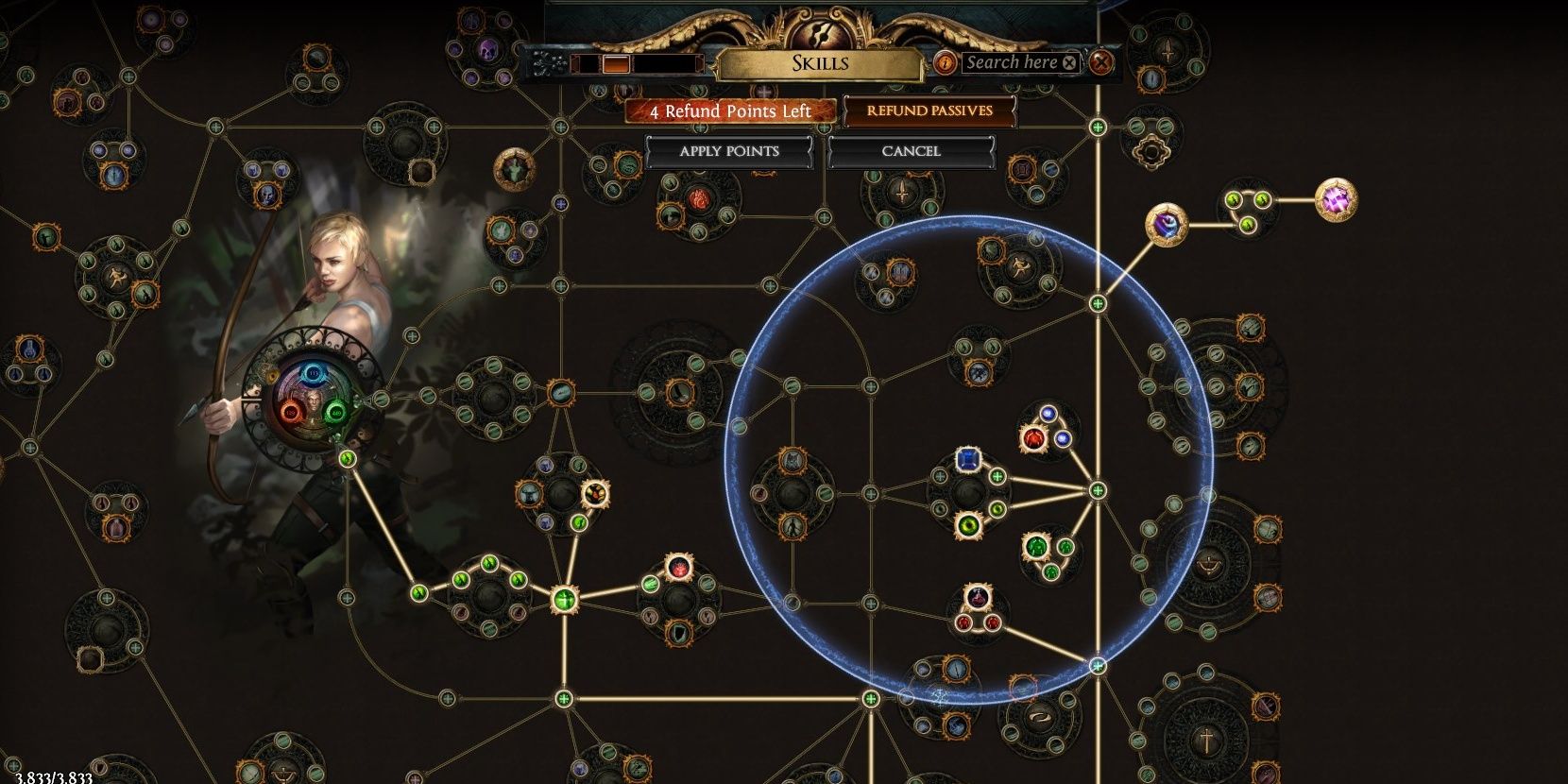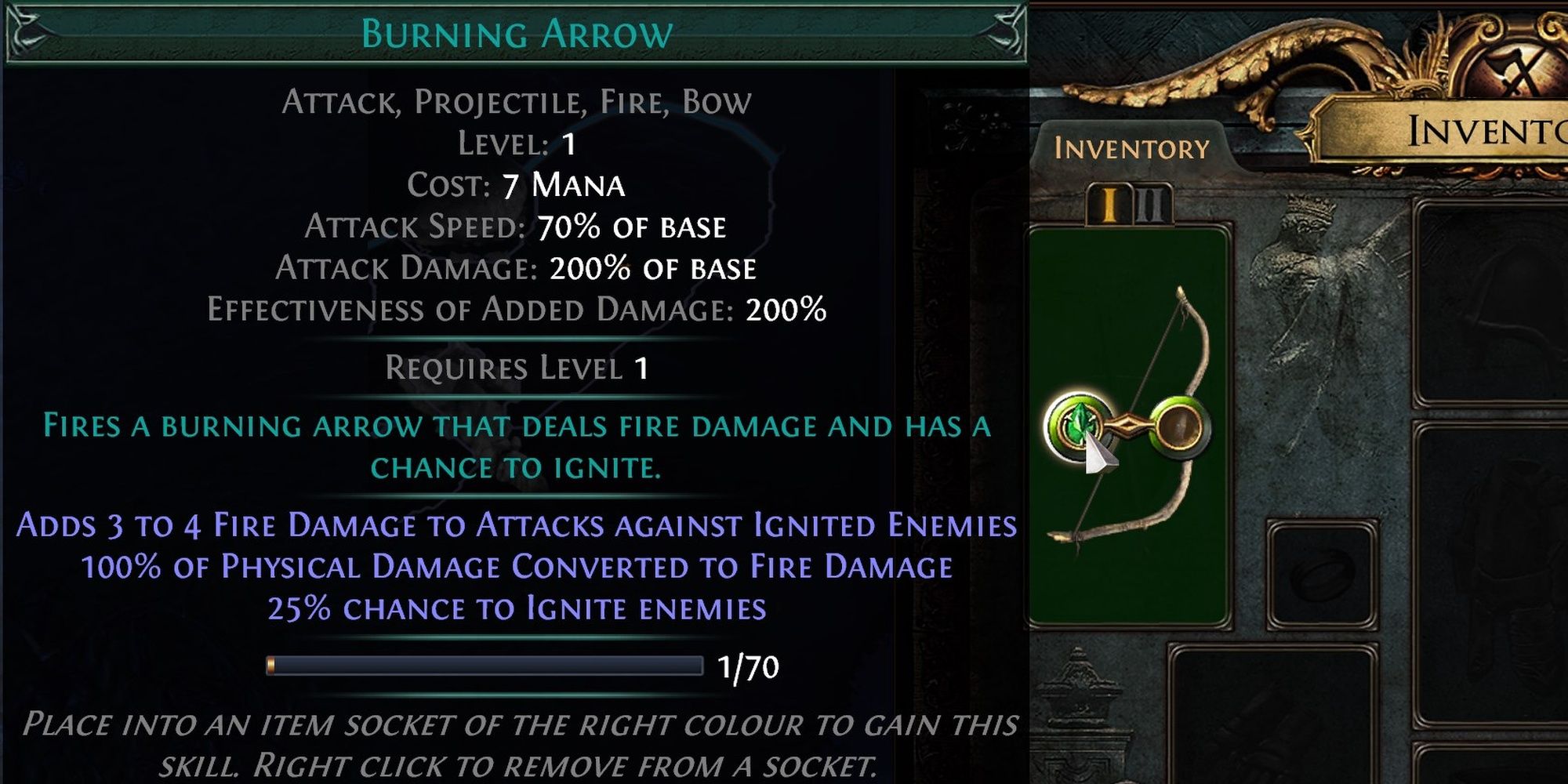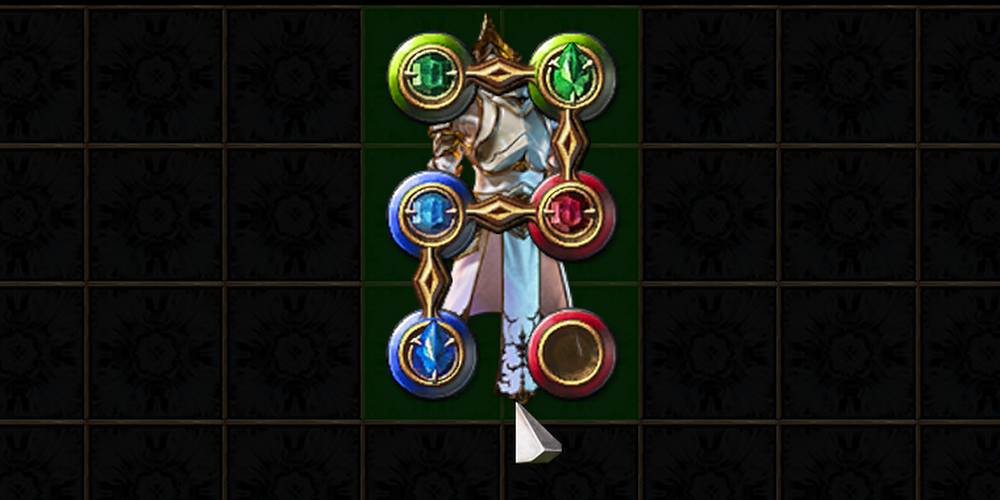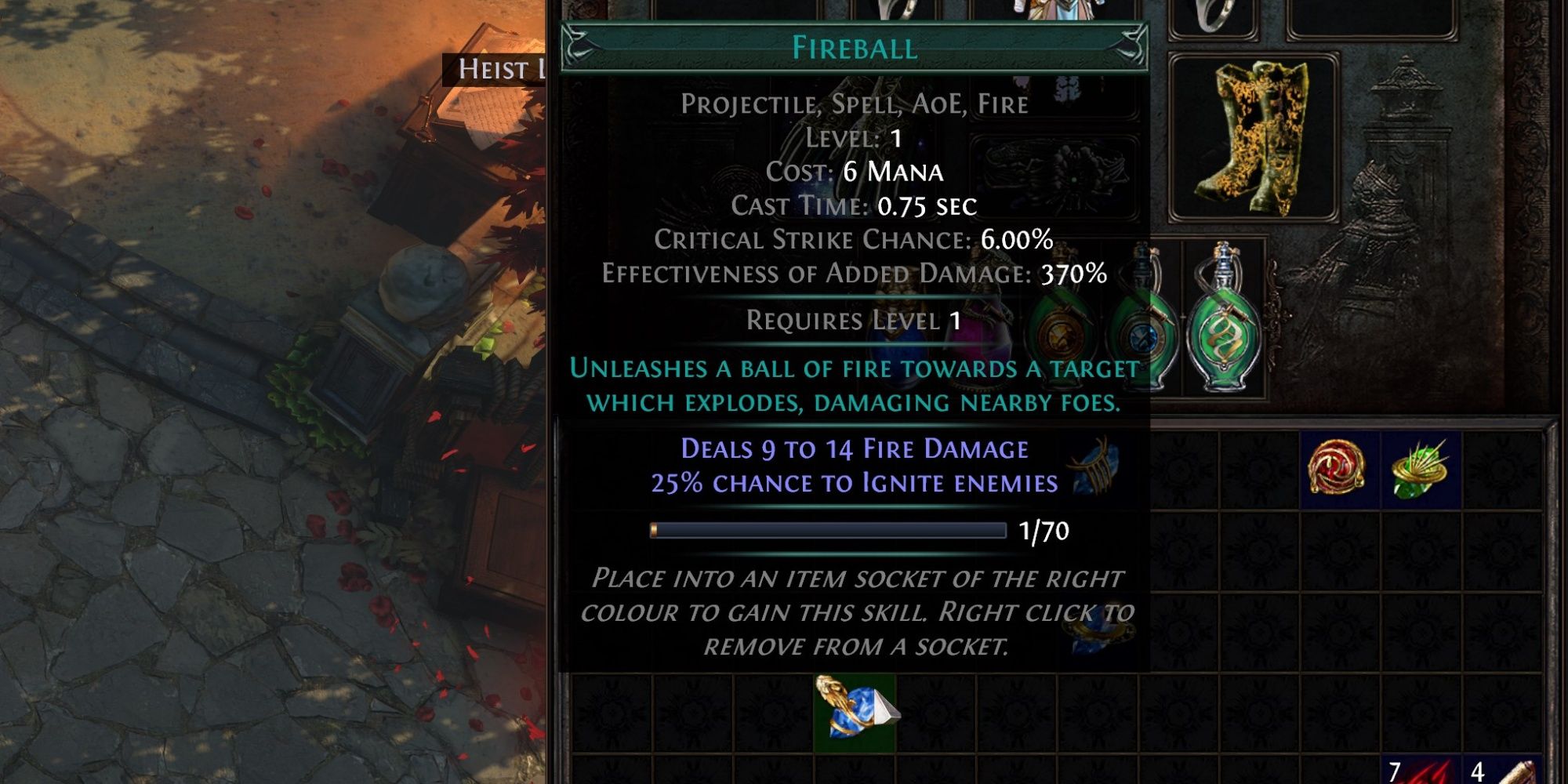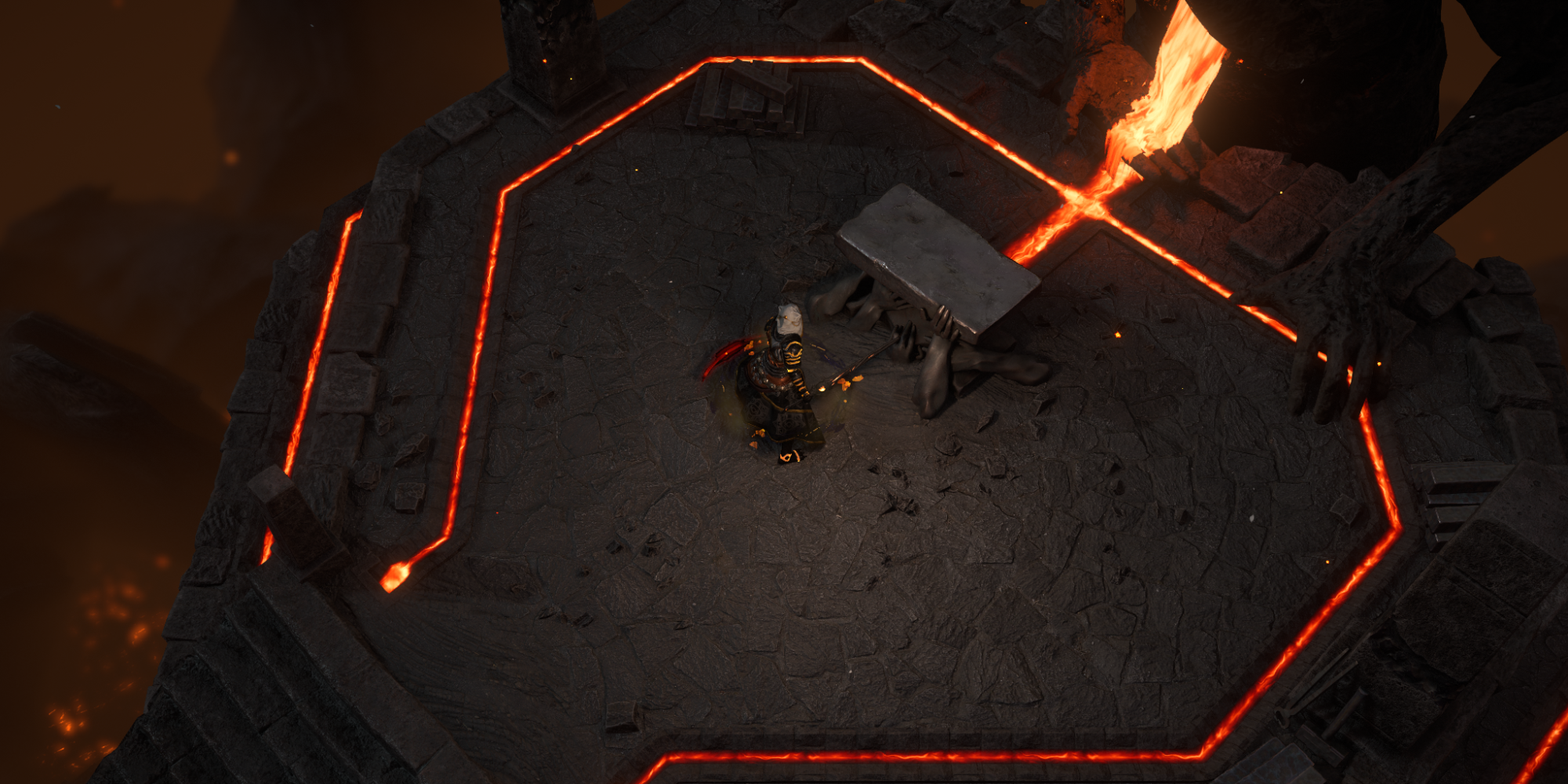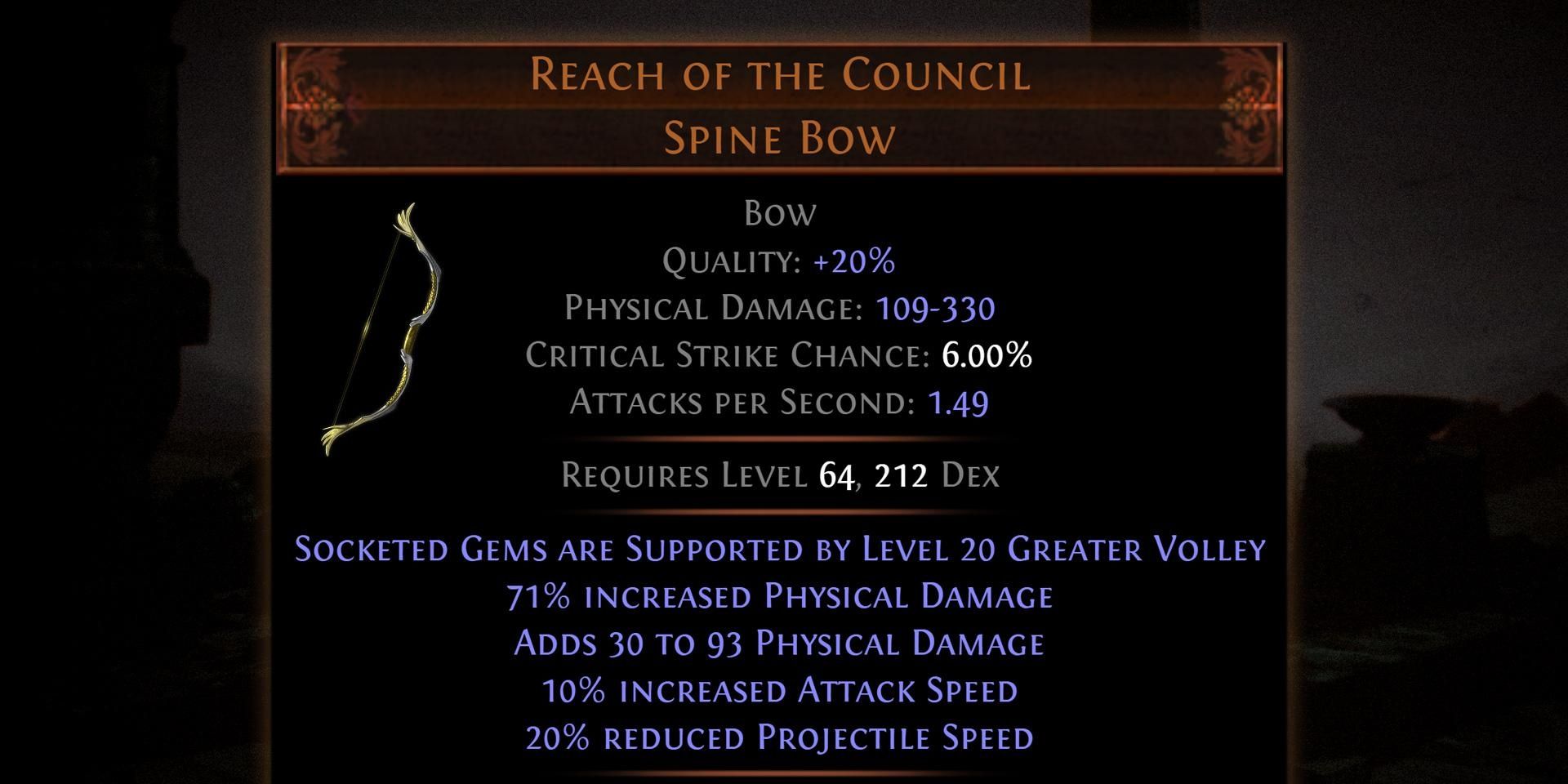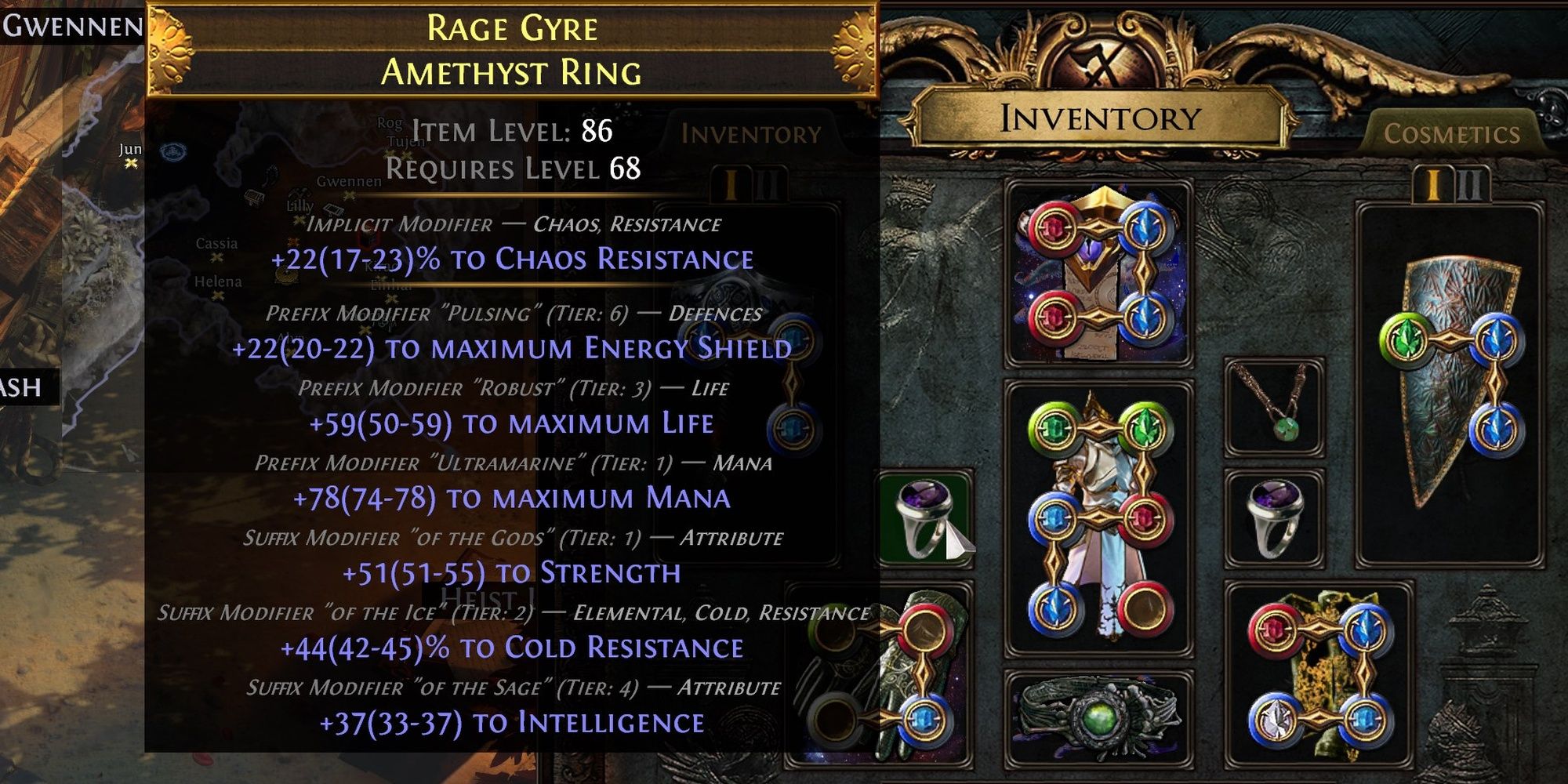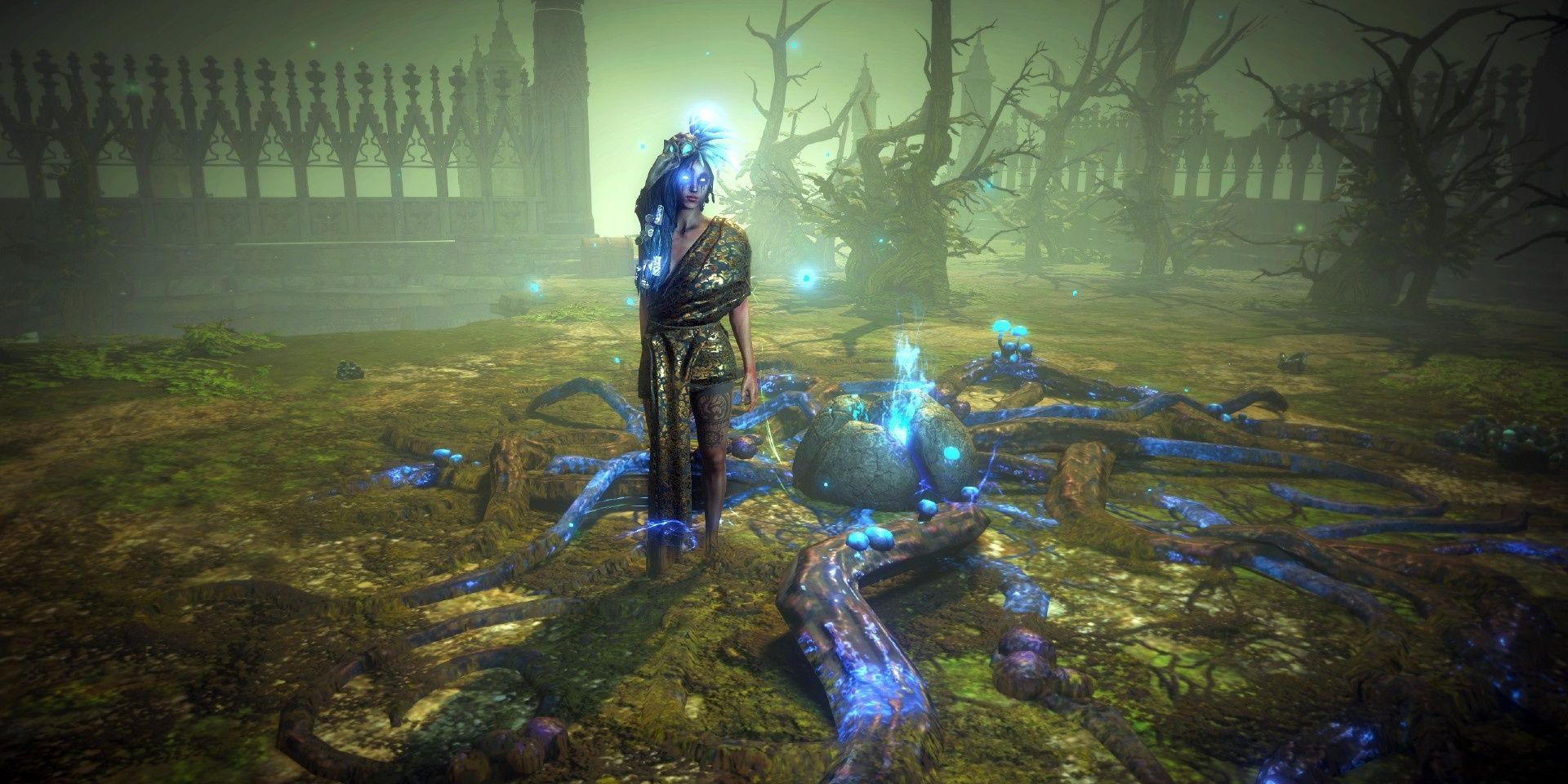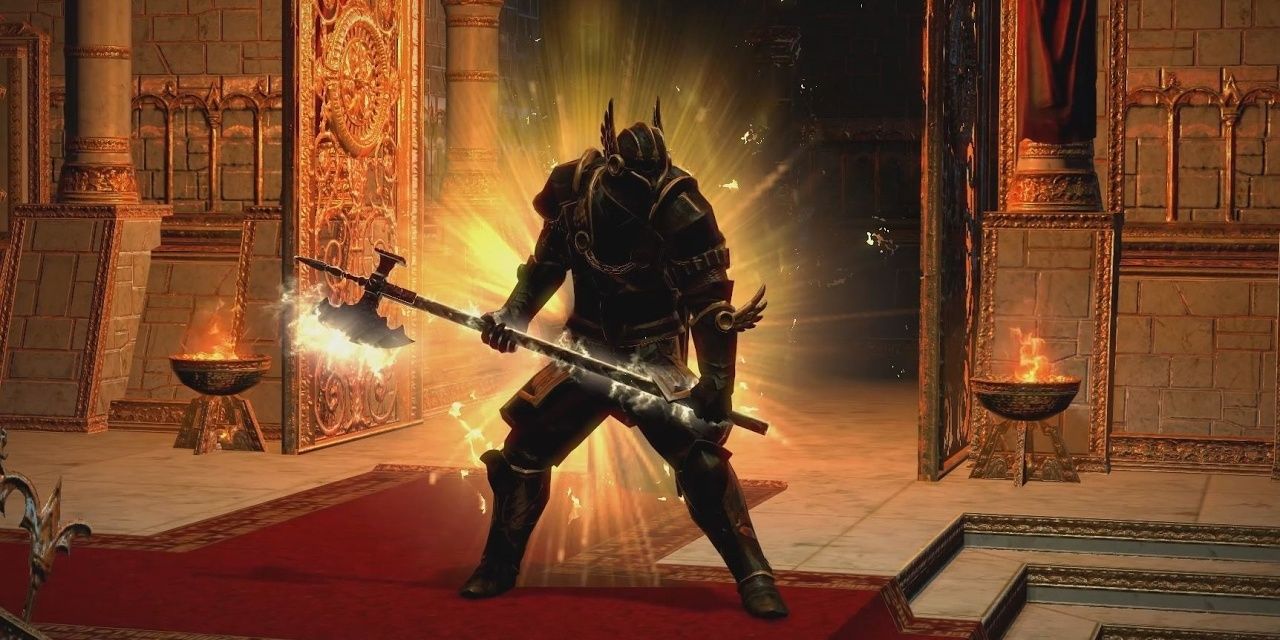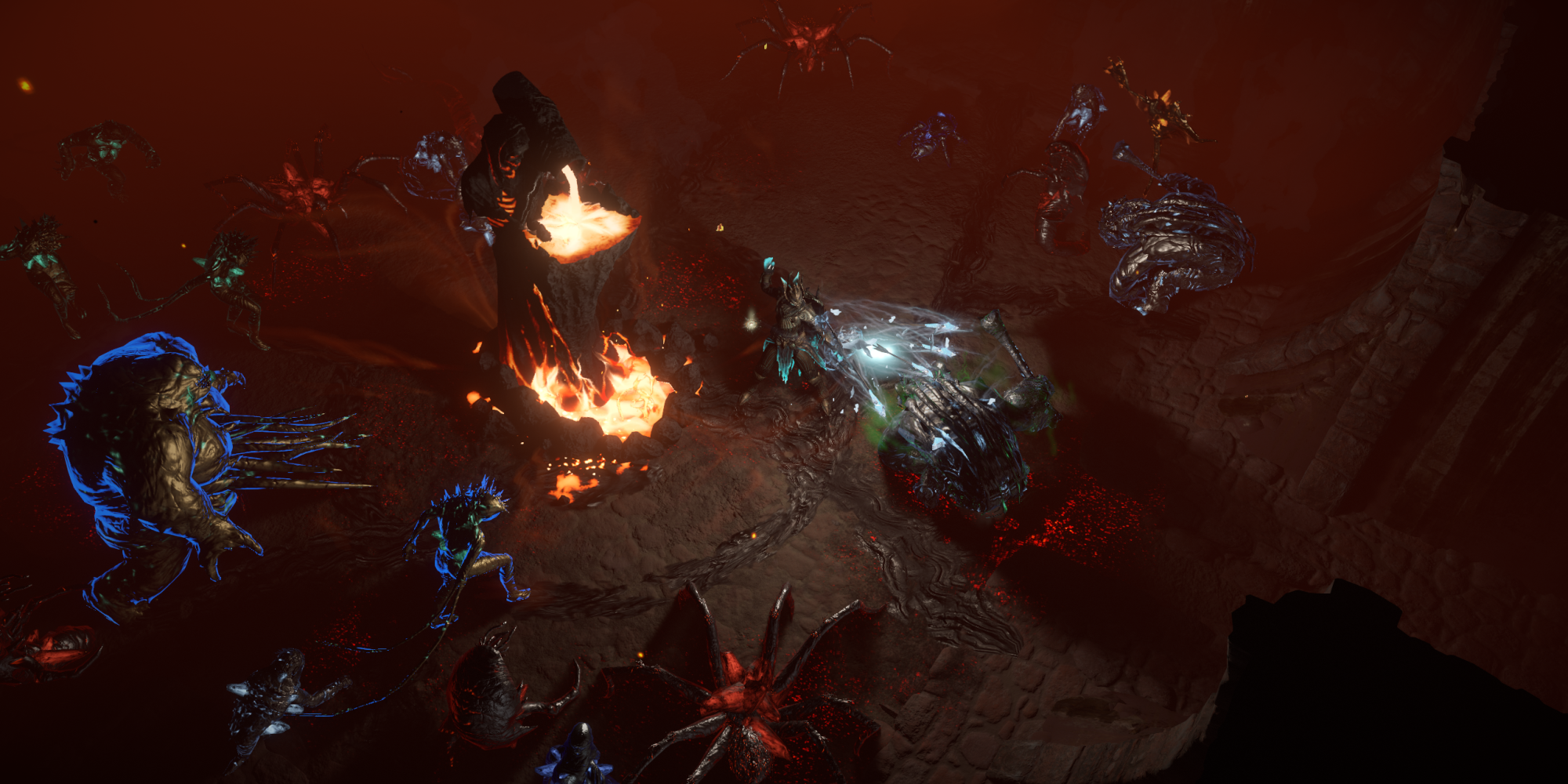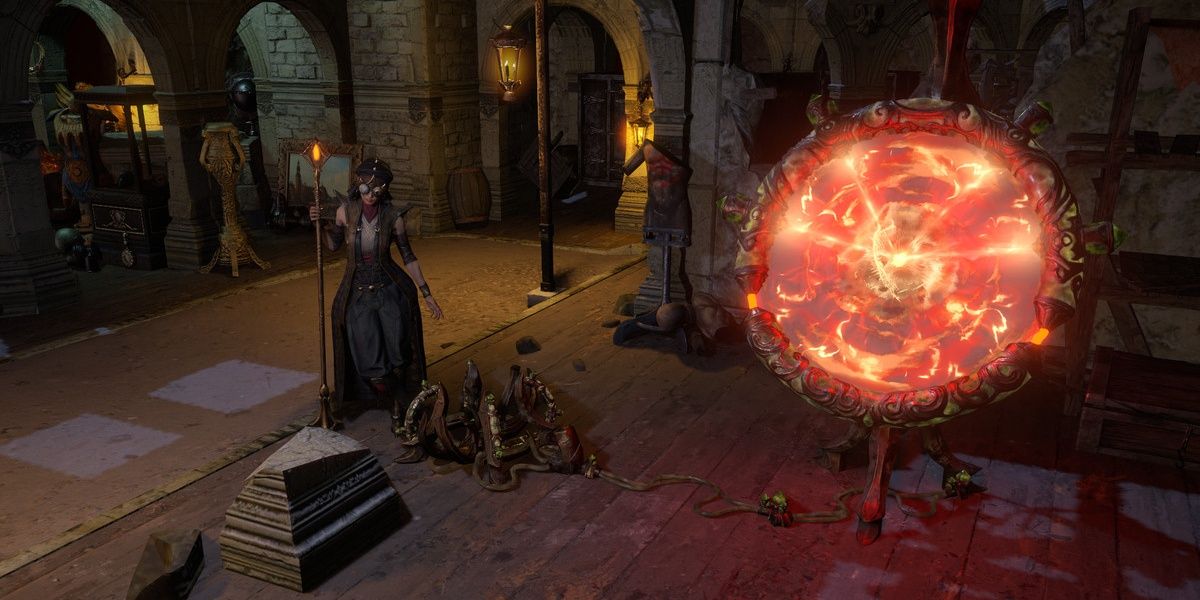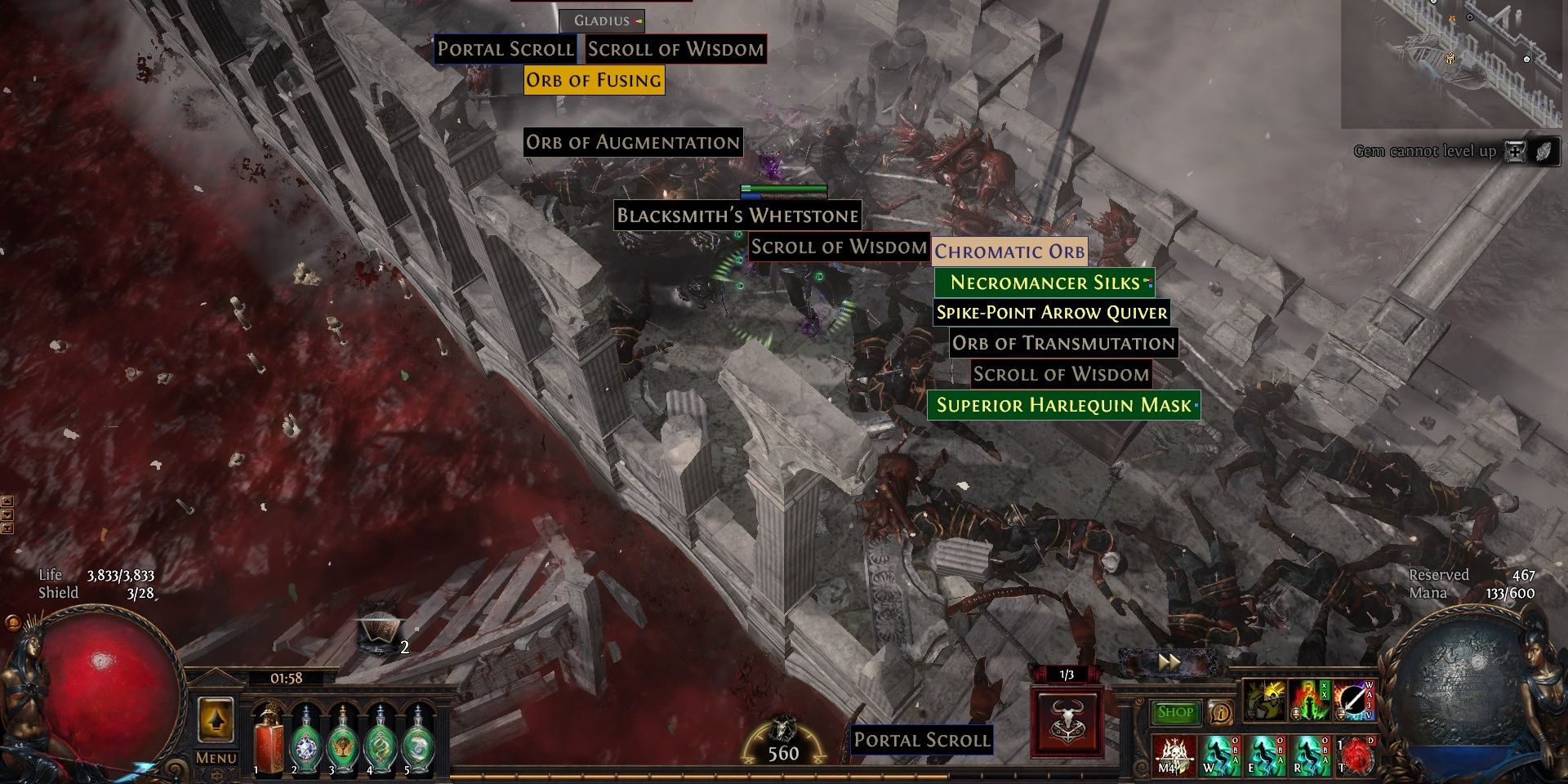Quick Links
No ARPG on the market can match the sheer depth of Path of Exile. This free-to-play dungeon crawler offers a degree of customization that would make other games blush. Everything from your skills to your endgame experience can be suited to your needs.
Unfortunately, Path of Exile's depth comes at the cost of accessibility. This is easily the most obtuse dungeon crawler out there, but don't let that dissuade you. Waiting beyond the game's brutal campaign lies one of the most feature-rich, diverse, and satisfying ARPGs in the genre. To help break down that insurmountable barrier, we've created this guide as a resource for players to reference when needed. Let's start by covering the cornerstone of most RPG games: classes.
Updated April 23, 2023, by Charles Burgar: Path of Exile has made some massive changes since our last republish during Ritual League. Multiple leagues and expansions have greatly changed the difficulty and overall progression of Path of Exile, requiring us to update our beginner's guide. To help you start your journey on Wraeclast, we've rewritten nearly every section of this article for 3.21 Crucible League, updating everything from character creation information to adding a survival guide for the first few Acts. We've also overhauled the formatting of this guide to be much easier to read, including new tables, jump links, and a table of contents for easier navigation.
Creating A Character
Making a character in Path of Exile requires two things:
- Choosing a league.
- Picking your class.
Both decisions will have a significant impact on your play experience, so choose carefully. You cannot change your class once you create your character, although leagues are somewhat more fluid. Hardcore characters that die will be migrated to Softcore instead of being deleted outright, and the Solo Self-Found restriction can be opted out of at any time if you created a character with this difficulty variant enabled.
Path Of Exile Leagues Explained
Leagues are variants of Path of Exile's core game, adding new mechanics that augment the core game experience. For example, update 3.21's Crucible League adds molten forges in each zone that can be used to add passive trees to your weapons and shields. Leagues typically last for three months. When a league ends, your characters and your stash will be migrated to Standard. If your character was made in Hardcore League, it'll be migrated to Hardcore instead.
Generally, we recommend playing in the Softcore version of the current league, as most league mechanics tend to give bonus power to the player in some form. Leagues also have a fresh economy that makes buying and selling items easier than in the permanent Softcore and Hardcore game types.
As for what all the league modifiers mean:
|
League Option |
Description |
Duration |
|---|---|---|
|
Standard |
Base Path of Exile. No temporary mechanics exist, and the economy has never been reset. Death imposes an XP penalty. |
Permanent |
|
Hardcore |
Base Path of Exile. No temporary mechanics exist, and the economy has never been reset. Death migrates your character to Standard. |
Permanent |
|
League |
Path of Exile with a new mechanic. The economy has been recently reset, and all characters migrate to Standard when the league ends. Death imposes an XP penalty. |
3-4 Months |
|
Hardcore League |
Path of Exile with a new mechanic. The economy has been recently reset, and all characters migrate to Hardcore when the league ends. Death migrates your character to Standard. |
3-4 Months |
|
Difficulty Modifiers |
||
|
Solo Self-Found |
A self-imposed challenge where you play solo and never trade with other players. You may opt out of SSF any time by joining a party. |
Until you opt out |
|
Ruthless |
A significantly harder version of Path of Exile. Item drops are rarer, skill gems must be found, crafting is much harder, and some mechanics are disabled. Death imposes a massive XP penalty. |
Permanent |
|
Hardcore Ruthless |
A significantly harder version of Path of Exile. Item drops are rarer, skill gems must be found, crafting is much harder, and some mechanics are disabled. Death will delete your character. |
Permanent |
Once again, we recommend picking the default league for most players. If you feel overwhelmed by PoE's systems, you might want to give Ruthless a try. Ruthless is significantly slower than standard Path of Exile and places a larger emphasis on item drops due to item scarcity, making it paradoxically easier to find upgrades for your character. The slower pace also helps with learning boss fight mechanics.
Choosing A Class
Classes in Path of Exile dictate two key elements:
- Your starting position in the passive tree.
- Your available Ascendancies—Path of Exile's take on prestige classes.
Unlike most ARPGs, classes do not dictate which skills you can use. Path of Exile itemizes its skill system so that any class can use any skill—something we'll cover later in the guide. For now, just know that classes do not impose build restrictions. If you want to play a Templar that summons zombies and uses a bow, you can.
Each class in Path of Exile still fills an archetypal role due to their location in the passive tree and their core attributes. There are three core attributes in Path of Exile, all of which should be familiar if you're a seasoned ARPG player.
- Strength (STR): Scales Life and increases melee physical damage.
- Dexterity (DEX): Grants Accuracy rating and increased Evasion rating.
- Intelligence (INT): Provides Mana and increased maximum Energy Shield—effectively a second life pool that behaves differently.
As for the classes themselves, there are seven in total:
The Scion class is not unlocked by default. Players must free her near the end of Act 3 before she becomes a playable character.
|
Class |
Attributes |
Tree Location |
Builds |
|---|---|---|---|
|
Marauder |
STR |
Bottom Left |
Best suited for melee builds |
|
Templar |
STR/INT |
Top Left |
Best suited for Brands and Man-focused builds |
|
Witch |
INT |
Top |
Best suited for spellcaster and minion builds |
|
Shadow |
INT/DEX |
Top Right |
Best suited for damage-over-time, trap/mine, and triggered spell builds |
|
Ranger |
DEX |
Bottom Right |
Best suited for projectile builds |
|
Duelist |
DEX/STR |
Bottom |
Best suited for tanky close-range builds |
|
Scion |
STR/DEX/INT |
Middle |
Jack-of-all-trades character. Best suited for niche builds that need more passives. |
Every class is available from the start excluding Scion. Each class starts in its own section of the passive tree (as seen above). As implied, the passive tree itself is the same between every class, hence its intimidating size. In theory, a Ranger could path to the top right of the tree near the Templar starting region, although this is highly inefficient in practice and usually not worth doing.
Beyond the starting passive tree location, your class also determines your Ascendancy options, Path of Exile's take on prestige classes. Partway through the campaign, you'll be given the opportunity to complete Labyrinth Trials that, when completed, will unlock a new zone called the Labyrinth.
Clearing the Labyrinth will let you pick between one of three Ascendancies—excluding the Scion who only gets one Ascendancy option. Ascendancies come with their own passive tree that substantially increases your power. You can view each Ascendancy tree on the Path of Exile website.
Finding A Build
Before you create a character and start playing Path of Exile, it's important to have a rough idea of what kind of build you're interested in making. Having a build in mind will dictate what kind of passives you'll take, which Ascendancy you'll pick, and what kind of gear you'll be chasing. Because of this, we highly recommend you look up a build guide to follow. Build guides give you an easier way of learning PoE's passive tree and gearing systems without worrying about making any major build mistakes.
Don't worry about bricking your character in PoE. Nearly all choices can be respecced, even Ascendancy choices.
That's not to say that it's impossible to play PoE without a guide. If you want to jump straight in and experiment, you absolutely can, but you might hit some progression walls along the way. If you're determined to make a character without a guide, we recommend playing blind until you hit a major progression wall. With your newfound knowledge, make a second character tailored toward your favorite skill. If that character gets stuck, repeat the process or look up a build guide.
As for good build guides, league starter builds are a good place to start. These seldom require any hard-to-find items and should come with leveling suggestions. Some good builds include:
-
Pohx's Righteous Fire Juggernaut
- On the website, select "RF Jugg League Starter" for the current patch. It'll take you straight to the build guide.
-
Zizaran's Leaguestarter Series
- The above link is for 3.21 Crucible League. For future leagues, visit Zizaran's YouTube channel.
- Tripolarbear's Cold DoT Elemantalist
- Enki's Arc Witch
Surviving The First Few Acts
Right after you create your character, you'll get your hands on a weapon and a skill gem. Skills are itemized in Path of Exile and are placed directly into an item's sockets. Socketing a skill gem will grant access to that skill, provided you're using the right weapon type and have enough stats. These skills can be further augmented through support gems socketed onto the same item, provided the sockets are linked together. Use your newfound skill to defeat Hillock, using your flasks whenever you run low on HP or Mana. Grab any items they drop and head to Twilight's Strand.
Move Only Keybind
PC users that want an unconditional movement button can bind a specific button to move only. Click on any skill socket on the bottom-right of your skill bar and select the "Move Only" skill icon. We recommend binding this to left-click for ease of use.
Some of the items Hillock drops will be unidentified and unable to be equipped. To identify an item, use a Scroll of Wisdom on the unidentified item. You'll start with three Scrolls of Wisdom when you make your character. You can get more from slaying monsters or by selling common items to vendors. You'll always want a stack of Scrolls of Wisdom in your inventory whenever possible.
If you've interacted with any of the trading NPCs in town, you might have noticed that they buy and sell items in a wide range of currencies. Path of Exile does not have Gold. Players instead accumulate a wide range of crafting currencies that can be traded with vendors, other players, or used to modify their character or items. We cover all common currency types in the expandable section below, but the gist is you want to grab any currency items you stumble across. Orbs of Transmutation, Alteration, Chaos Orbs, and the like are all valuable in their own way.
Once you've talked with the NPCs and got some quests, continue to progress through Act 1. Along the way, you'll want to make note of the following tips:
- After completing the "Mercy Mission" quest, select the Quicksilver Flask as your reward. This drastically boosts your movement speed while active.
- Keep your eyes out for boots that increase your movement speed.
- Have one movement skill equipped at all times. Some good ones include Frostblink, Flame Dash, and Leap Slam.
- In The Lower Prison, you'll find an optional trap gauntlet. Successfully navigate it to complete a Trial of Ascendancy. Complete the other five trials throughout the next two Acts to unlock the Labyrinth and your Ascendancy class.
-
Obtain a Sapphire Ring before fighting Merveil, the final boss of this Act. Sapphire Rings grant a substantial boost to your Cold Resistance.
- If you can't find one, you can make one by selling an Intelligence (blue) Skill Gem and an Iron Ring to any vendor.
Act 2 Tips
The second Act is much less linear than the first. You'll be tasked with defeating three bandits that control small portions of the region. Your character will gain permanent passive buffs based on how you deal with the bandits:
- Spare Oak: Gain 20% increased physical damage, 2% additional physical damage reduction, and regenerate 1% of Life per second.
- Spare Alira: Gain 15% to all elemental resistances, 20% global critical strike multiplier, and regenerate 5 Mana per second.
- Spare Kraityn: Gain 6% increased movement speed, 10% chance to avoid elemental ailments, and 6% increased attack and cast speed.
- Kill Every Bandit: Gain +2 passive skill points.
For nearly all builds, we recommend killing every bandit for the extra passive points. Some league starters might recommend killing Alira for the added elemental resistances, so anyone following a build guide will want to double-check before continuing the main quest. If you regret the choice you made later in your playthrough, you can respec your bandit choice by selling 20 Regret Orbs alongside a specific attribute amulet to any vendor.
Making A Hideout
After freeing Helena from the Chamber of Sins, you can speak with her in the Forest Encampment to create a personal hideout. You can fast travel to your hideout at any time from any Waypoint. Hideouts allow you to access crafting benches, certain endgame NPCs, and a personal map device for PoE's endgame content.
Shortly after starting the Act, you'll also meet Einhar, a beastmaster that oversees the Bestiary mechanic. Einhar will ask to hunt alongside you for most of Act 2, capturing any tough beasts you find. When you've captured a few beasts, Einhar will ask you to use the Blood Altar to improve your items. The Blood Altar can be accessed at The Menagerie, an instanced zone accessible from the fast travel menu. It'll appear as a small circle with a beast icon.
Access the zone, interact with the Blood Altar at the center of the arena, and select the crafting recipe you wish to use. This will create a combat trial where you must slay the beasts you captured. Kill the beasts to complete the recipe and finish this quest. This gives you a short introduction to the Bestiary mechanic and Beast Crafting. You can now return to Act 2 to finish the main questline.
As for some general tips:
- You'll find two Ascendancy Trials in this zone. One is in The Chamber of Sins (Floor 2), and the other is in The Crypt.
- When searching for Alira in The Western Forest, look out for a stone path perpendicular to the main road. This always leads to her camp. Conversely, the opposite end leads to the Weaver's Nest.
- Don't forget to talk to Bestel in Act 1 after completing the quest "The Way Forward" to receive your skill point reward.
Act 3 Tips
Path of Exile's third Act returns to a linear format and is slightly longer than the previous Acts. While the layout of Sarn is somewhat confusing, the quests themselves are rather straightforward. There are two things you should be focusing on at this point:
- Completing all Ascendancy Trials to unlock the Labyrinth
- Getting your Fire, Cold, and Lightning Resistances to 75%.
You should have completed three Ascendancy Trials from the previous Acts. This Act has three more Trials to complete. You'll find them in The Crematorium, The Catacombs, and The Imperial Guardians. Once you've completed all six Trials, return to the Sarn Encampment and interact with the goddess statue in the center of town. This will open a portal to the Aspirant's Trial, the location of the Labyrinth.
As the name implies, the Labyrinth features a series of connected zones that are filled with deadly traps and monsters. You must defeat the boss of the Labyrinth, Izaro, three times in total to complete the Labyrinth. You only get one life in this zone, so play cautiously. Consider modifying your flasks with the 'Staunching' modifier to remove Bleed on use. You can either roll this modifier randomly with Orbs of Alteration or craft it from the Menagerie's Blood Altar. Clearing the Labyrinth unlocks your Ascendancy class.
Beyond that, you'll want to find gear that increases your Fire, Cold, and Lightning Resistances. These resistances are vital to staying alive in Acts 5-10 in the campaign, as the enemies are balanced around you having capped resistances. If the item also has bonuses to Life, you'll be set for the next few Acts.
Checking Your Resistances
You can view your resistances and other character modifiers through your character sheet. PC users can press 'C' to open this menu. Console users can navigate to the 'Character' tab while in their inventory to access the same screen.
If at any time you get stuck or can't seem to find an upgrade, you can take advantage of the crafting table within your hideout. If not already placed, you can use the edit feature within your hideout to place a crafting table. This will let you forge item modifiers onto your gear, provided it has open affix slots. For example, you can add a modifier that increases spell damage onto your wand for some added damage while leveling. Adding a modifier is as simple as putting an item on the crafting bench and selecting a recipe.
Crafting recipes are unlocked as you progress through the Acts and PoE's endgame systems. Keep your eyes peeled for floating tablets while leveling, as these unlock new crafting recipes when interacted with. Focus on finding gear with four linked sockets, Life, and resistances. Attack build will also want to upgrade their weapon every few Acts to ensure their damage doesn't fall off. Follow these tips, and you should be able to clear Path of Exile's campaign with some practice.
General Tips
- Reach 75% Fire, Cold, and Lightning Resistance ASAP! Path of Exile is balanced around your character having capped resistances. These resistances will be permanently reduced by 30% at the end of Act 5 and Act 10, so it is imperative you find gear that counteracts this negative. You can check your resistances in the defense tab of your character sheet ('C' by default on PC).
- Remember to use support gems. Support gems provide a massive boost to your skill's damage and overall effectiveness. Be sure your main skill is buffed by multiple support gems throughout your playthrough to maximize your damage.
- Flasks are extremely strong and should be used often. You gain flask charges from killing monsters and leveling up. If your build has good clear speed, your flasks should always be active.
- Don't grab everything you see! Your inventory is extremely small in Path of Exile. Focus on grabbing rare items, jewels, and currency. Alternatively, install a loot filter (explained in the "Must-Have Community Tools" section).
The Passive Tree And Ascendancies
Path of Exile's passive tree is notorious for its size and complexity. It might seem that way on the surface, but the tree becomes much simpler once you realize that your passive tree's job is to boost your survivability and damage. Many of the nodes on the passive tree can be completely ignored depending on your build. For example, if you're a spellcaster, none of the weapon wheels on the left and right-hand sides of the tree will be particularly useful to you. That same spellcaster might be scaling Energy Shield, so now Life doesn't matter as much.
The point is that your passive tree should enhance the core aspects of your build. If you're playing a bow character, you'll probably benefit from grabbing bow and projectile nodes. If you are a Life build, scaling Life is a good idea. Once you start looking at the tree in this way, it becomes substantially less intimidating.
The only build-enabling effects found on the passive tree are Keystone buffs that typically come with some downside. For example, Necromatic Aegis gives your minions a copy of your shield, a massive buff to their survivability. As a downside, you no longer benefit from your own shield, changing your gearing options slightly.
Masteries
Some node clusters on the passive tree have an additional node you can allocate called a Mastery. Masteries are unique passives that can be accessed from any Mastery Wheel on the passive tree. For example, a Life cluster on the passive tree might have a Life Mastery at the very center. Once you allocate that wheel's notable passive, you'll be able to allocate a Life Mastery for an additional passive point. Any Life Wheel can allocate any Life Mastery, regardless of location. This behavior applies to all Mastery types.
For example, let's say you're playing a build that scales Cold damage. You want to convert your Physical Damage to Cold, so you look at grabbing the Cold Damage Mastery that converts 40% of Physical Damage to Cold. Instead of pathing to a specific node on the tree, you just need to allocate points into any Cold Damage Wheel and grab that Mastery. Masteries have more powerful, build-enabling effects than your typical notable passive, hence why they can be accessed from multiple locations in your passive tree. Respeccing a Mastery is the same as any other passive, requiring one respec point either from a Book of Regret (quest reward) or Orb of Regret (currency type).
Earning Passive Points
Passive points come from two sources in Path of Exile:
- Leveling up
- Completing certain quests
A surprising amount of Path of Exile's side quests grant passive points when completed. Passive points are integral to reaching your build's fullest potential, which is why completing these quests is paramount for any player.
For a comprehensive list of every quest that grants passive points, consult this wiki article.
Ascendancies
Every class in Path of Exile has a prestige class that can be unlocked throughout the course of the campaign. Named Ascendancies, these prestige classes offer a unique passive tree that each grant build-enabling features. Every class except Scion has three Ascendancies they can choose from—the Scion only gets one Ascendancy option.
To unlock an Ascendancy, you must complete a series of trap gauntlets named the Trials of Ascendancy. There are twelve you can find in the campaign, the first six being required to earn your prestige class. When the first six Trials are complete, interact with the statue in Act 3 to open the Aspirant's Trial, allowing you to enter the Lord's Labyrinth. Successfully completing a Labyrinth run without dying unlocks your Ascendancy.
There are four variants of Labyrinth that each grant Ascendancy points when cleared for the first time. The first six Trials unlock Normal Labyrinth, the next three unlock Cruel, and the final three unlock Merciless Labyrinth. A fourth difficulty is also available once you reach Path of Exile's endgame, giving you a total of eight Ascendancy points to spend.
For a list of Ascendancies and their respective nodes, consult this Path of Exile webpage.
What is likely more useful for you are the locations for each Trial. They are listed below in order of appearance:
Additionally, players can complete the Eternal Labyrinth once they reach Maps, Path of Exile's endgame. Completing a Labyrinth Trial that randomly spawns in a Map will grant an Offering to the Goddess, a currency type required to start an Eternal Labyrinth run. Finish the run without dying to receive your final two Ascendancy points.
Skill Gems And Support Gems Explained
Skills in Path of Exile are provided by your gear instead of your chosen class. Nearly every skill is provided by a skill gem, a small item that can be socketed into weapons, armor, and certain jewelry. As long as you meet the skill gem's attribute and level requirements, you can equip it.
Note that the color of your skill gem dictates what gem socket it can enter. For example, a Dexterity-focused skill gem that's green can only go in items with a green or white socket. You can view an item's sockets by hovering over it with your cursor.
You can have gem sockets appear on items at all times by toggling the "Always Show Sockets" option in the options menu.
Newly socketed skills will automatically appear on your skill bar on the bottom right of your screen. If you wish to change a skill's input, click on your skill bar and select the skill you want to be bound to that input.
To recap:
- Purchase or find a skill gem you wish to use.
- Equip a weapon or armor piece with a gem socket that matches the color of said skill gem.
- Socket the skill gem into your item.
- Bind the skill to an input of choice (found on the bottom right of your screen on PC).
Support Gems
This is where most players get confused. Support gems are socketable gems that solely provide buffs to skill gems. These gems support skills; they do not grant skills.
For example, someone that finds their Fireball spell lacking damage can slot in the Combustion support gem to enhance its fire and burning damage. Combustion didn't add a new skill, it supported Fireball, hence why they're called support gems.
Two things are needed for a support gem to work:
- A link must be connecting the skill gem and support gem sockets on the gear piece.
- Both gems must share at least one tag.
Gem Links
Gear links are golden lines that connect gem sockets together. The example chest armor shown above has six sockets, yet it only has four links connecting the sockets. Players typically refer to this as a "five-link" armor piece since five sockets are linked together.
If you can't tell if an item is linked, socket a skill gem and a Support Gem onto an item. If you hover over your skill gem, the Support Gem should glow. If it doesn't, the item isn't linked.
Gem Tags
Tags are a simple concept that most newer players overlook. To keep things simple, tags are keywords that showcase which modifiers can impact that skill. For example, a skill gem with the 'AoE' tag is affected by increases and reductions to AoE damage, AoE size, and similar AoE modifiers. You can find a gem's tags directly under the name of the gem. If both a skill and support gem share at least one tag, they are compatible with each other. Let's analyze a skill gem together to show this system in action.
Fireball is a straightforward spell in most ARPGs. Your character spawns a flaming projectile that hits targets. Tags break this spell down into core characteristics that support gems can bend. In Fireball's case, it has the Projectile, Spell, AoE, and Fire tags as seen under its name. This means that any Support Gems that have at least one of those four properties can affect Fireball.
Let's say you wanted Fireball to shoot three projectiles instead of one. You could consider using the Lesser Multiple Projectiles support gem.
The tags on this gem read "Support" and "Projectile," meaning it can support any skill with the Projectile tag. Since Fireball has Projectile as one of its tags, Lesser Multiple Projectiles will work. Now your Fireball will be firing three projectiles with each cast instead of one.
As you can see, the system isn't too complicated on its own. Just keep gem tags in mind if you can't easily determine if a support gem would work for a certain skill.
How To Upgrade Your Gear
Items are an integral part of Path of Exile. A good item can drastically increase your damage, improve your survivability, or provide a build-enabling effect. Covering the ins and outs of every item is far beyond the scope of a beginner's guide, but you'll want to have a general idea of how items work in PoE and which stats are worth chasing. This section will cover how item rarities work, how to upgrade your items, and explain how damage scaling works.
Gear
Items in Path of Exile drop in one of four different rarities:
- Normal: An item with no prefixes or suffixes. In other words, an item with minimal modifiers. These items are common.
- Magic: An item with one prefix and/or suffix. These items are uncommon.
- Rare: An item with up to three prefixes and suffixes. Rare items are the most powerful in the game. These items are uncommon, although good rares are hard to come by.
-
Unique: Items with properties that can't be found elsewhere. Unique items range from uncommon to extremely rare.
- These are not Legendaries. Uniques enable builds, typically with a negative associated with them.
As with most ARPGs, items come with a suite of randomly-rolled modifiers that provide offensive and defensive stats. For 99% of cases, modifiers come in the forms of prefixes and suffixes. Prefixes and suffixes are not the same; they both have a different pool of modifiers. For example, modifying the player's Life stat is a prefix, while adding resistances is a suffix mod. Both are vital to making a character tanky, but they both come from different mod pools.
Hovering over an item and holding the 'Alt' key (clicking the left thumbstick on console) will showcase which mods are prefixes and suffixes. This will also showcase stat tiers and roll ranges for each affix.
For a full list of potential modifiers on an item, consult the Path of Exile database website—poedb for short. Only experienced players should visit this website, as it is really easy to get overwhelmed while looking at an item's pool of modifiers.
Crafting
Learning every aspect of crafting is far beyond the scope of this guide, but it's important to mention that Path of Exile has a wide range of crafting systems you can use to improve your items. The most common way to upgrade your items is through your hideout's crafting bench. Inserting an item into your crafting bench will let you craft prefixes and suffixes onto the item for a small cost, assuming the correct affix slot is open. This is known as 'bench crafting' by the community. By default, you can only have one benchcrafted modifier on an item at a time.
Some other crafting methods you should know about include:
- Essences: You can use Essences to reroll items, guaranteeing a specific modifier that's listed on the Essence you use. Higher-tier Essences provide modifiers that are impossible to obtain elsewhere.
- Harvest: Completing Harvest encounters rewards Lifeforce which can be used at the Horticrafting station in your hideout. This is effectively a second crafting bench with far stronger crafting options.
- Bestiary: The Menagerie's Blood Altar has powerful crafting options available if you own the right beasts. You can split items apart, shuffle prefixes and suffixes, and add unique Aspect buffs to your gear.
-
Betrayal: NPCs tied to this mechanic commonly drop Veiled items, unlocking new crafting recipes when unveiled.
- Veiled Chaos Orbs and certain Betrayal NPCs can forge Veiled modifiers onto your items that are much stronger than what you can bench craft.
- Delve (Fossil Crafting): Delve drops Fossils which can be socketed into Resonators, behaving similarly to Chaos Orbs. Fossils can make modifiers more likely to appear or block certain outcomes entirely.
If you want to know more about Path of Exile's crafting systems, check out YouTuber subtracrem's crash course on crafting in PoE.
Resistances
One of the first things you'll notice jumping into Path of Exile is how hard this game is. Enemies frequently one-shot you at later Acts, and the game doesn't do a great job explaining why this is.
Path of Exile is balanced around your Fire, Cold, and Lightning Resistances being capped at 75%. Most enemies deal some form of elemental damage, so it's imperative that you reach the 75% cap as soon as possible. You can check your resistances by opening your character sheet (default 'C' on PC). Physical Damage can be mitigated by scaling Armour, Evasion, and Endurance Charges. Chaos Damage does not count as elemental damage and must be scaled separately. Aiming to keep your Chaos Resistance at 0% or higher is recommended.
When you finish Act 5 and Act 10, you will permanently lose 30% to all elemental resistances. Try to overcap your resistances by 30% before completing either of these Acts.
Why Damage Scaling Matters
In Path of Exile, a good defense requires an overpowering offense. If you can kill enemies before they can react, you'll take zero damage since they never got a chance to retaliate. This is why so many builds focus on outputting as much damage as quickly as possible. To one-shot everything on your screen, you'll need to understand how damage scaling works. We'll give a general overview of how damage scaling works, but as with most things in Path of Exile, following build guides and making your own builds are the fastest ways of learning.
Increase Vs. More
Scaling your damage in Path of Exile can happen through one of two modifiers: additive multipliers and multiplicative modifiers. Here's what both terms mean:
-
Additive: Multiple sources of additive damage are added together before damage calculation.
- Referred to as "increased damage" in-game
-
Multiplicative: These damage sources are multiplied together when damage is calculated.
- Referred to as "more damage" in-game
You can remember both as additive and multiplicative. Path of Exile refers to these modifiers as "increased" and "more," respectively. Increased modifiers are powerful while leveling, as you won't have many sources of multiplicative damage yet. More modifiers are much stronger in the endgame, as they will exponentially increase the damage you dish out.
Be sure you're obtaining flat sources of damage as well. Most attack builds get their base damage through weapons, and spellcasters typically get their damage through gem levels. This is why most attack builds prioritize increasing their weapon's DPS while spellcasters typically focus on increasing gem level.
There are exceptions to the rule above, notably "increased damage taken" modifiers. These are multiplicative since they multiply the damage an enemy takes.
Damage Scaling Sources
In general, you'll be scaling your build's damage through your passive tree, gems, gear, and Ascendancy. There are more ways to scale your damage than that, but that's the gist.
Flat Damage Sources
- Weapons
- Skill gems (typically spells)
- Certain support gems
- Certain Uniques
Increased Damage Sources
- Passive Tree nodes
- Gear (local modifiers)
More Damage Sources
- Support gems
- Elemental penetration/reductions
- Ascendancy notables (varies from class to class)
- Keystones from the passive tree
- Certain flasks
In general, if you want to make your build stronger, the best things to do are:
- Upgrade your gear
- Level your skill and support gems
- Link more support gems to your skills
- Ascend (if possible)
- Penetrate enemy resistances
There are far more ways of scaling your damage than these, but this should give you a rough idea as to what you should be focusing on when your damage starts falling off in later Acts or Maps.
Useful Community Resources
Before you delve into the harsh world of Wraeclast, you should know of a few community resources that make the game much more enjoyable. As solid as Path of Exile's endgame and crafting systems are, quality of life is not the game's strong suit. Fortunately, the community has fixed most of these pain points.
- Neversink's Loot Filter: Default filter for console players. This loot filter will only show items relevant to you. Garbage items are hidden from view, and rarer items are given unique backgrounds and font sizes. This is downright mandatory on PC. Installing this filter is explained in the "Loot Filters" subsection.
- Path of Exile Trade: You can find, purchase, and sell items through this website. If you own a Premium Stash Tab (obtained from the in-game item shop), you can list items from your Stash Tab on this website with no hassle.
-
Path of Exile Community Wiki: Provides information on every aspect of Path of Exile.
- Avoid using the Gamepedia version of the wiki as it's outdated. "poewiki.net" is the most up-to-date version.
-
Path of Building Community Fork (POB): You can create builds and configure character stats and gear with this app. It is handy for theorycrafting builds and sharing ideas with members of the community. The community fork is more up-to-date.
- Guides that include "POB" links are referring to Path of Building.
- PoELab: If you keep dying in Labyrinth runs, this website is a blessing. It provides a map detailing the current Labyrinth layout, room modifiers, and Izaro traits.
- Awakened PoE Trade: This tool lets you look up an item's value through a simple keystroke. This tool does not break the game's TOS, and it is straightforward to use. A tutorial on how to use this tool can be found here.
Loot Filters
Loot filters allow players to filter out lackluster items while making useful items more apparent. There are a wide range of loot filters for Path of Exile, the most commonly used filter being Neversink's Loot Filter. Let's go over how to install it.
The easiest way to install this filter is to sync a Neversink loot filter with your Path of Exile account. From the FilterBlade.xyz website, create a loot filter, select the "Save & Export" tab, name your filter, then click "Sync or Download." You'll want to sync the loot filter to your PoE account. Log into your PoE account to save the loot filter.
Once finished, boot up PoE and enter character selection. Head to your options menu, then under the "Game" tab you'll find your loot filter options. Select the Neversink filter and save. That loot filter will remain applied until you change it, even if you uninstall PoE or play on a different system.


